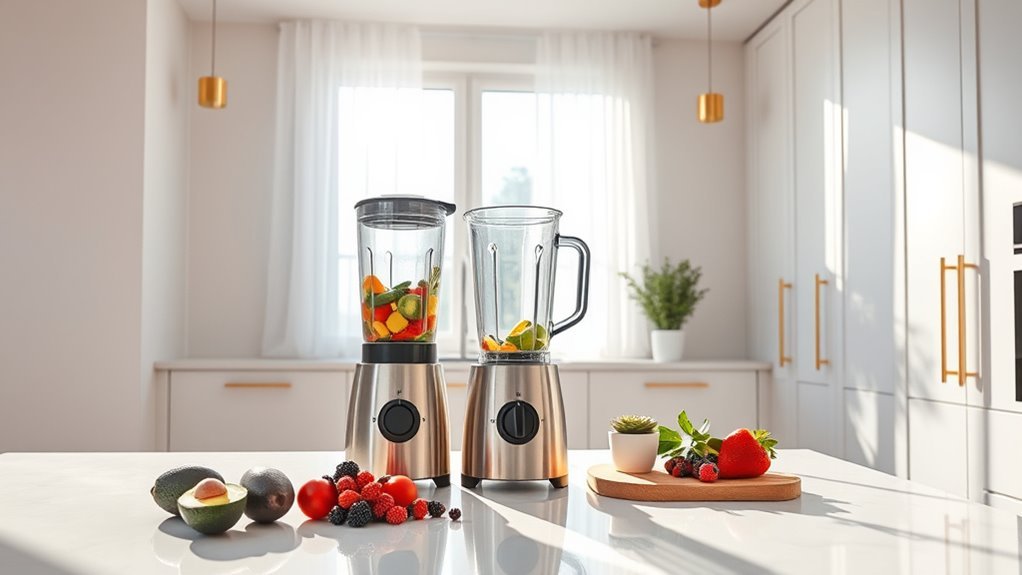We need BPA-free blender jars because traditional plastic containers leach harmful endocrine-disrupting chemicals into our smoothies. With 93% of people already having detectable BPA levels, we can’t risk more exposure through daily blending. Glass, stainless steel, or Tritan containers offer safer alternatives that prevent chemical contamination while maintaining peak blend performance. Smart material choices protect our hormonal health – and that’s just the start of why proper blender jars matter.
Understanding BPA and Its Health Impacts

While you’re blending up those morning smoothies, there’s an invisible guest that might be crashing your health party – BPA.
We’re talking about endocrine disruptors that leach from certain plastics straight into your carefully crafted nutrition.
Let’s cut to the chase: chemical leaching from food contact surfaces isn’t just scientific jargon – it’s a real threat. When BPA seeps into your smoothie, it disrupts hormonal imbalances and creates serious health risks.
We’re all exposed (93% of us have it in our bodies), and the FDA’s “it’s fine” stance doesn’t match mounting evidence.
Here’s the smooth truth: toxic chemicals don’t belong in your blender.
We’re switching to safer materials – BPA-free options and glass containers that protect your smoother health journey.
It’s time to blend without the chemical baggage.
The Benefits of BPA-Free Blender Materials
Since we’ve established the risks of BPA exposure, let’s explore why BPA-free materials are revolutionizing blender design. These safer materials, particularly Tritan, effectively prevent chemical leaching while handling high temperatures and acidic ingredients – an essential factor in food preparation.
We’re not just talking about a trendy feature. BPA-free blenders directly combat serious health issues like hormonal imbalances and metabolic disorders. By choosing a non-toxic blender, we’re investing in our long-term well-being. Additionally, high-performance blenders often utilize these BPA-free materials, ensuring that the final product remains free from harmful contaminants.
Manufacturers now prioritize transparency about their materials, making it easier for us to select products that protect our health. The peace of mind that comes with using BPA-free blender jars isn’t just psychological – it’s backed by solid science and smart engineering that keeps harmful chemicals away from our smoothies.
Top Materials for Safe Smoothie Blending

Now that we recognize why BPA-free matters, let’s get specific about the materials that’ll keep your smoothies safe.
We’ve identified the top choices for health-conscious consumers who want to avoid chemical leaching, especially when blending hot or acidic ingredients.
- Glass containers offer supreme safety with zero chemical interactions
- Stainless steel containers provide durability and won’t retain flavors
- Tritan plastic, while BPA-free, requires careful UV protection
- Traditional plastics marked “BPA-free” may contain BPS or BPF – avoid these
- High-grade borosilicate glass withstands temperature changes best
For maximum safety, we recommend glass or stainless steel options.
They’re worth the investment to protect against endocrine disruptors, and they’ll keep your smoothies pure and chemical-free.
Don’t compromise – your health depends on safe materials.
Choosing the Right BPA-Free Jar Size
Getting your blender jar size right can make or break your smoothie game. We’re seeing more BPA-free options hitting the market, but volume capacity matters most. Let’s match your needs with the perfect jar size.
| Jar Size | Best For | Blending Efficiency |
|---|---|---|
| 32 oz | Singles | Quick, consistent |
| 48 oz | Couples | Medium batch time |
| 64 oz | Families | Longer blend time |
For ideal blending efficiency, we recommend jars with a wider base – they’ll dramatically reduce scraping and guarantee smoother texture. Don’t forget to check compatibility with your blender model. Larger jars need more blending time, but they’re perfect for meal prep. Single-serve jars blend faster and offer grab-and-go convenience. Choose based on your typical serving size and frequency of use. Additionally, high-performance blenders often come with larger jar capacities, which can greatly enhance cooking efficiency in your kitchen.
Maintenance Tips for BPA-Free Blender Jars

While maintaining your BPA-free blender jar might seem straightforward, it’s critical to follow specific care guidelines to maximize its lifespan and safety.
We’ve compiled essential maintenance tips to protect your safe materials from chemical leaching and degradation.
- Hand wash your jar with mild soap and warm water – never use abrasive sponges that can scratch the surface.
- Let hot foods cool before blending to prevent heat-induced chemical leaching.
- For stubborn residue from acidic foods or high-fat ingredients, soak in a vinegar-water solution for 15-30 minutes.
- Skip the harsh chemicals – they’ll damage your BPA-free material and compromise its integrity.
- Store your blender jar in a cool, dry spot away from direct sunlight to prevent material breakdown.
These simple steps will keep your BPA-free blender jar performing safely for years to come.
Frequently Asked Questions
Are Bpa-Free Blenders Safe?
Like walking on thin ice, we can’t be completely certain about BPA-free blenders. While they’re better than BPA options, some alternatives still raise health concerns, so we recommend researching specific materials and brands.
Is Glass or Plastic Better for Blenders?
We recommend glass for its better durability, heat resistance, and easier cleaning, though plastic’s lighter weight and lower cost are appealing. Glass won’t retain flavors but can break, while plastic’s eco-impact is higher.
What Type of Blender Is Best for Making Smoothies?
Like a tornado in your kitchen, we recommend high-performance blenders with powerful motors. For daily smoothies, choose personal blenders with glass jars, durable blades, and variable speeds for perfect consistency.
Do Blenders Leach Microplastics?
We’re exposed to microplastics when plastic blenders break down during smoothie preparation. Let’s choose glass or stainless steel alternatives to minimize health risks and guarantee food safety while blending.

